Related Research Articles
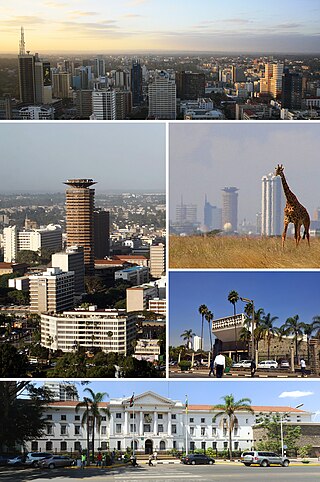
Nairobi is the capital and largest city of Kenya. The name is derived from the Maasai phrase Enkare Nairobi, which translates to 'place of cool waters', a reference to the Nairobi River which flows through the city. The city proper had a population of 4,397,073 in the 2019 census. The city is commonly referred to as The Green City in the Sun.

Mombasa is a coastal city in southeastern Kenya along the Indian Ocean. It was the first capital of British East Africa, before Nairobi was elevated to capital status in 1907. It now serves as the capital of Mombasa County. The town is known as "the white and blue city" in Kenya. It is the country's oldest and second-largest city after Nairobi, with a population of about 1,208,333 people according to the 2019 census. Its metropolitan region is the second-largest in the country, and has a population of 3,528,940 people.

Moyale is a city on the border between Ethiopia and Kenya. In Ethiopia, Moyale is the administrative centre for two Ethiopian woredas, Moyale of Oromia Region and Moyale of Somali Region. In Kenya, it is the largest town of Marsabit County and the capital of Moyale sub-county.
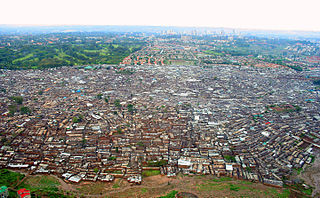
Kibera is a division of Nairobi Area, Kenya, and neighbourhood of the city of Nairobi, 6.6 kilometres (4.1 mi) from the city centre. Kibera is the largest slum in Nairobi, and the largest urban slum in Africa. The 2009 Kenya Population and Housing Census reports Kibera's population as 170,070, contrary to previous estimates of one or two million people. Other sources suggest the total Kibera population may be 500,000 to well over 1,000,000 depending on which slums are included in defining Kibera.
Lang'ata is a predominantly middle-class residential suburb of Nairobi in Kenya. The suburb consists of many smaller housing developments, referred to as estates. They include Nairobi Dam, Otiende, Southlands, Ngei, Jambo estate, Onyonka, Madaraka Estate, Kutch Prant, Rubia, NHC Langata, Akiba, Sun Valley, Royal Park and many others. These developments are primarily maisonettes or apartment blocks.
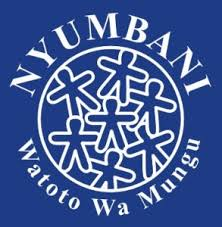
The Nyumbani Children's Home was founded by Father Angelo D'Agostino and Sister Mary Owens in 1992 to serve mostly abandoned children created by the AIDS pandemic. Since then, three more programs have been added to the organization.

Embakasi is a neighbourhood in the city of Nairobi. It is approximately 18 kilometres (11 mi), southeast of the central business district. Embakasi is considered part of Nairobi's Eastlands area, lying to the south-east of Nairobi County. The Embakasi proper covers other estates in Eastlands such as Donholm, Pipeline, Tena, and Makadara estates. It borders South C and contains South B and slightly more than one third of Nairobi's Industrial Area and Export Processing Zones.

Mathare is a collection of slums in Nairobi with a population of approximately 500,000 people; the population of Mathare Valley alone, the oldest of the slums that make up Mathare, is 180,000 people. Mathare is the home of football teams Mathare United and Real Mathare of the MYSA. Mathare is currently part of two electoral constituencies; the titular Mathare Constituency and the northern part being in Ruaraka Constituency. The northern part was initially part of Kasarani Constituency up to the 2013 elections when Kasarani was split into three electoral constituencies; Ruaraka being among them. The southern part was domiciled in Starehe Constituency.
Lang'ata Constituency is an electoral constituency in Nairobi City County. It is one of the seventeen constituencies in the county. It consists of southern and southwestern areas of Nairobi. Langata constituency had common boundaries with a now defunct Kibera Division of Nairobi. It is the largest constituency in Nairobi with an area of 196.80 km2 (76.0 sq mi). It was known as Nairobi South Constituency at the 1963 elections but since 1969 elections it has been known as Lang'ata Constituency.
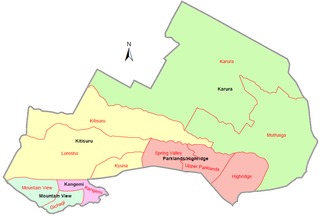
Westlands is an electoral constituency in Kenya. It is one of the seventeen constituencies in Nairobi County. The constituency is situated within Westlands Sub-county, formerly Westlands District. The entire constituency is located within Nairobi City County. The constituency has an area of 72.4 km2 (28.0 sq mi). It was known as Nairobi Northwest Constituency at the 1963 elections, then as Parklands Constituency and since 1988 elections it has been known as Westlands Constituency.

Korogocho is one of the largest slum neighbourhoods of Nairobi, Kenya. Home to 150,000 to 200,000 people pressed into 1.5 square kilometres, northeast of the city centre, Korogocho was founded as a shanty town on the then outskirts of the city.
South B is the name of a Division of the sub-county of Starehe in Nairobi, Kenya and the name of a "sub-location" of Mukuru Nyayo within the Division. The 2019 Kenya Census gives a population of 102,441 for South B Division and 34,216 for the sub-location. South B is about 3 kilometres (1.9 mi) south-east of Nairobi Central Business District; the Industrial Area lies to the east and the South C district to the south-west.
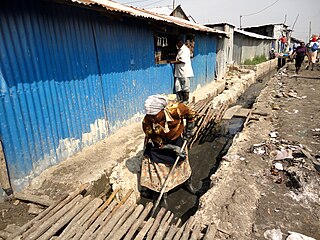
Mukuru Kwa Njenga is a slum in the Mukuru slums of Nairobi. Mukuru kwa Njenga is among other villages in Mukuru namely; Mukuru kwa Reuben, Mukuru kwa Njenga, Sinai, Paradise, Jamaica, Kingstone, Mariguini, Fuata Nyayo and Kayaba. The population exceeds 100,000.
Kawangware is a low income residential area in Nairobi, Kenya, about 15 km west of the city centre, between Lavington and Dagoretti.
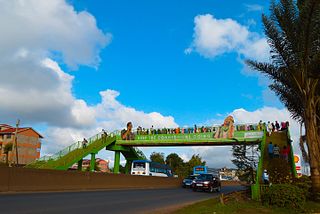
Uthiru is a settlement transversing in both Nairobi County and Kiambu County on the northwest side of the city centre of Nairobi. It is located between Kikuyu and Kangemi. The number of residents likely exceeds 100,000. It hosts a number of public institutions including University of Nairobi, Upper Kabete Campus, Kabete national polytechnic, and AHITI Kabete. ILRI has its headquarters in Uthiru.
Eco-Pesa is the name of a Kenyan community currency, used to reduce poverty and support environmental conservation in a slums areas inside the Kongowea Location, Mombasa District, Kenya. Pesa is a Swahili word for money. Eco-Pesa's was in circulation for one year and was considered the pilot that resulted in the more sustainable Bangla-Pesa model of community currencies that have been duplicated in five communities in Kenya and two in South Africa.

Pope Francis visited Kenya from 25 to 27 November 2015. It was his first state and pastoral visit to the country and the continent of Africa at large. Francis is the second pontiff to visit Kenya after John Paul II who visited Kenya 3 times. In his visit, he met the president of the Republic of Kenya, Uhuru Kenyatta, held meetings with various members of the clergy, held an open mass at the University of Nairobi and visited a poor slum neighbourhood of Kangemi. As a result of his visit, most of the roads in Nairobi were closed on Thursday and parts of Friday
Pipeline is a slum-like neighbourhood in Embakasi in the city of Nairobi. Located within the larger Eastlands area of Nairobi, it is approximately 9.5 kilometres (5.9 mi) east of the central business district. It has earned a reputation for its poor infrastructure, coupled with overcrowded flats, narrow streets, littering, as well as its poor drainage system.
Kayole is a low-income neighbourhood in the city of Nairobi. Located within the larger Eastlands area of Nairobi, it is approximately 11 kilometres (6.8 mi) east of the central business district.
Mountain View is a neighbourhood in the city of Nairobi. It is approximately 9 kilometres (5.6 mi) west of the central business district of Nairobi.
References
- ↑ "HEALTH-AFRICA: UNICEF Reports Five Million Child Deaths Every Year - IPS ipsnews.net". Archived from the original on 11 June 2011. Retrieved 15 August 2010.
- ↑ "Ethnic tensions dividing Kenya". 5 January 2008.
- ↑ "Home".
- ↑ "Home".
- ↑ "Kooperation". Archived from the original on 7 March 2009. Retrieved 15 August 2010.
- ↑ "Startseite".
- ↑ "Home Page". Archived from the original on 20 June 2010. Retrieved 15 August 2010.